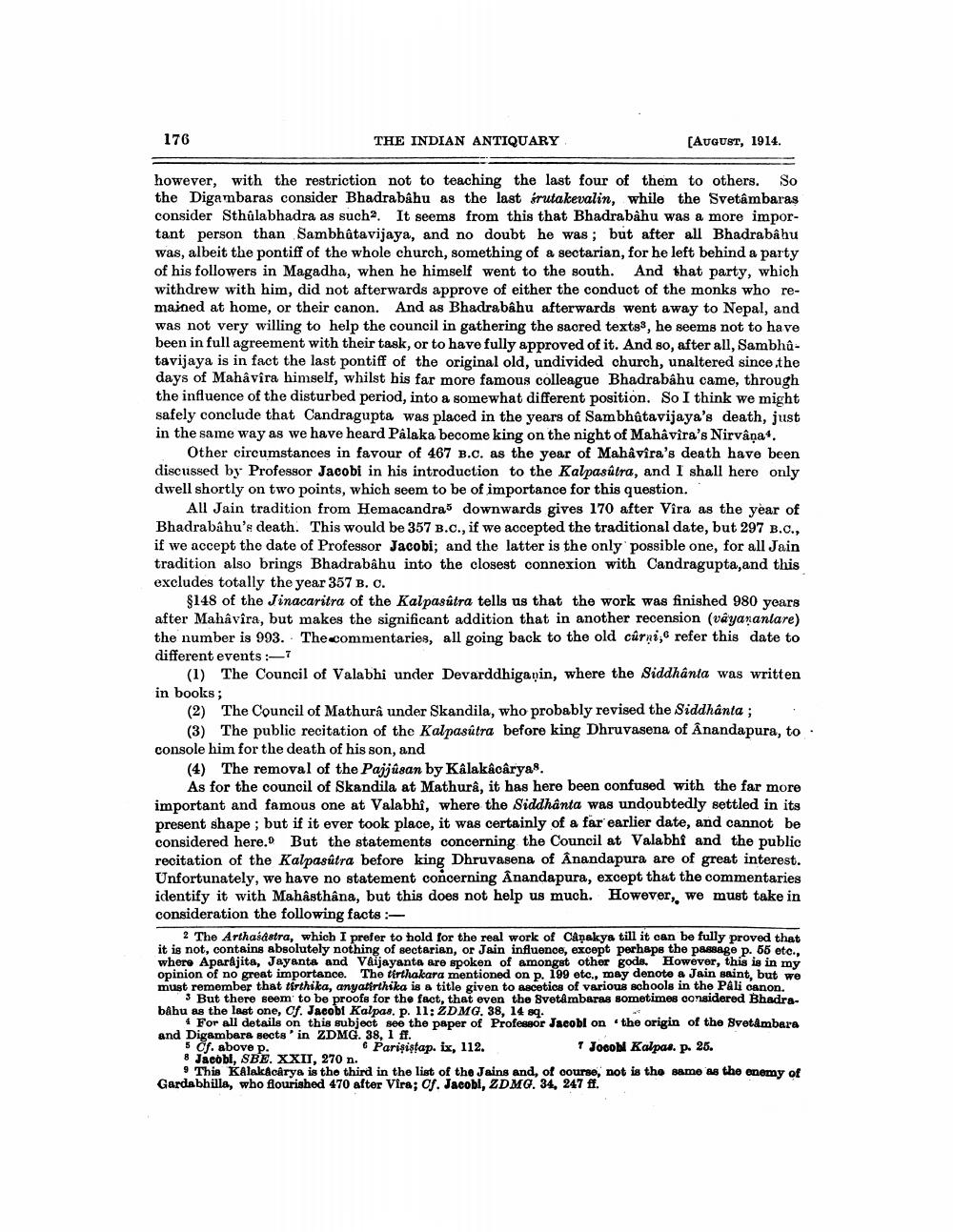________________
176
THE INDIAN ANTIQUARY
[AUGUST, 1914.
however, with the restriction not to teaching the last four of them to others. So the Digambaras consider Bhadrabahu as the last frutakevalin, while the Svetâmbaras consider Sthûlabhadra as such. It seems from this that Bhadrabahu was a more important person than Sambhậtavijaya, and no doubt he was ; but after all Bhadrabahu was, albeit the pontiff of the whole church, something of a sectarian, for he left behind a party of his followers in Magadha, when he himself went to the south. And that party, which withdrew with him, did not afterwards approve of either the conduct of the monks who remained at home, or their canon. And as Bhadrabâhu afterwards went away to Nepal, and was not very willing to help the council in gathering the sacred texts, he seems not to have been in full agreement with their task, or to have fully approved of it. And so, after all, Sambhatavijaya is in fact the last pontiff of the original old, undivided church, unaltered since the days of Mahavira himself, whilst his far more famous colleague Bhadrabahu came, through the influence of the disturbed period, into a somewhat different position. So I think we might safely conclude that Candragupta was placed in the years of Sambhậtavijaya's death, just in the same way as we have heard Palaka become king on the night of Mahavira's Nirvâņa.
Other circumstances in favour of 467 B.C. as the year of Mahavira's death have been discussed by Professor Jacobi in his introduction to the Kalpasútra, and I shall here only dwell shortly on two points, which seem to be of importance for this question.
All Jain tradition from Hemacandra5 downwards gives 170 after Vira as the year of Bhadrabahu's death. This would be 357 B.C., if we accepted the traditional date, but 297 B.C., if we accept the date of Professor Jacobi; and the latter is the only possible one, for all Jain tradition also brings Bhadrabahu into the closest connexion with Candragupta,and this excludes totally the year 357 B. C.
$148 of the Jinacaritra of the Kalpasútra tells us that the work was finished 980 years after Mahâvîra, but makes the significant addition that in another recension (vayananlare) the number is 993. The commentaries, all going back to the old cûrni;e refer this date to different events 7
(1) The Council of Valabhi under Devarddhigaộin, where the Siddhanta was written in books;
(2) The Council of Mathurâ under Skandila, who probably revised the Siddhanta ;
(3) The public recitation of the Kalpasútra before king Dhruvasena of Anandapura, to. console him for the death of his son, and
(4) The removal of the Pajjúsan by Kalakâcârya.
As for the council of Skandila at Mathurâ, it has here been confused with the far more important and famous one at Valabhî, where the Siddhanta was undoubtedly settled in its present shape ; but if it ever took place, it was certainly of a far earlier date, and cannot be considered here. But the statements concerning the Council at Valabhi and the public recitation of the Kalpasútra before king Dhruvasena of Anandapura are of great interest. Unfortunately, we have no statement concerning Ânandapura, except that the commentaries identify it with Mahâsthana, but this does not help us much. However, we must take in consideration the following facts :
2 The Arthasastra, which I prefer to hold for the real work of Canakya till it can be fully proved that it is not, contains absolutely nothing of sectarian, or Jain influence, except perhaps the passage p. 55 etc., where Aparajita, Jayanta and Vaijayants are spoken of amongst other gods. However, this is in my opinion of no great importance. The tirthakara mentioned on p. 199 etc., may denote a Jain saint, but we
anyatirthska is a title given to ascetics of various schools in the Pali canon. 3 But there seem to be proofs for the fact, that even the Svetåmbaras sometimes considered Bhadrabåhu as the last one, Cf. Jacob Kalpas. p. 11: ZDMG, 38, 14 sq.
For all details on this subject see the paper of Professor Jacobl on the origin of the Svetambara and Digambara sects' in ZDMG. 38, 1 ff. 5 Of. above p. Parisistap. ix, 112.
Josobl Kalpas. p. 25. 8 Jacobi, SBE. XXII, 270 n.
9 This Kalakácârya is the third in the list of the Jains and, of course, not is the same as the enemy of Gardabhilla, who flourished 470 after Vira; Of. Jacobi, ZDMG. 34, 247 ff.




